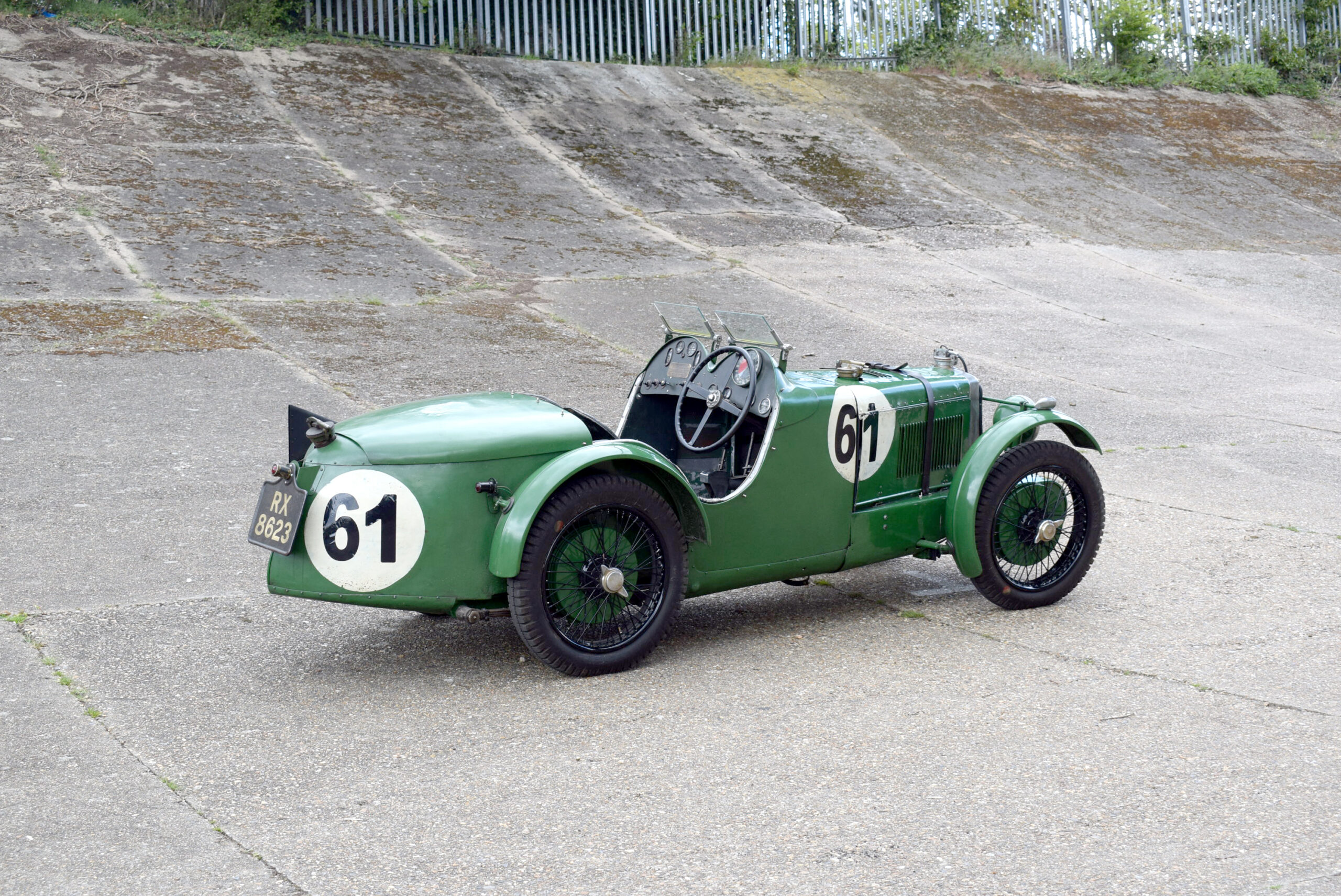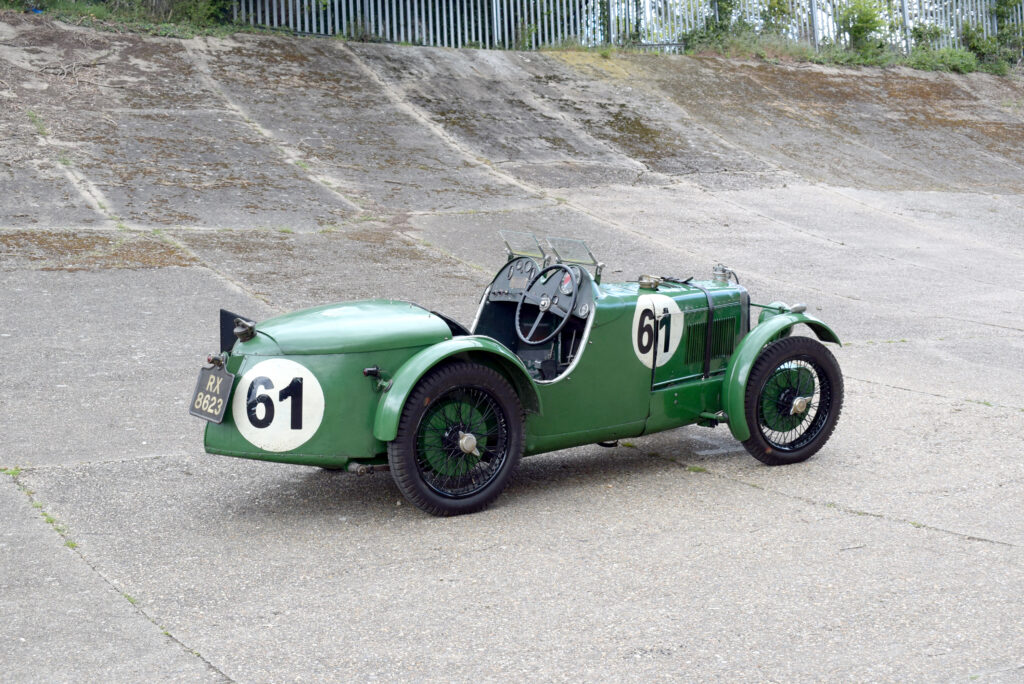Having languished in storage for over 40 years, and on the 90th anniversary of an historic year for MG, the only existing Earl of March team car has been brought back to life bringing with it memories of Brooklands halcyon days and the man that first brought motor sport passion to Goodwood.
Despite the towering motor sport legacy that was to follow, Freddie March’s personal foray into motor racing was actually quite brief – spanning just 3 years. The fact he competed for such a short time makes his considerable success all the more remarkable. Having struck out from the expectations of his grandfather by becoming an apprentice at Bentley, Freddie embarked on a life driven by a passion for engineering, motoring and aviation. Not surprisingly he soon gravitated toward Surrey and in 1929 entered an M.G. M-Type in the popular JCC High Speed Trial, earning a gold award for matching a carefully calculated average time over a technical and demanding course. The following year the Earl of March, partnered with Sammy Davis, won the gruelling 500 Mile race (all long distance races on the bumpy Brooklands track were ‘gruelling’) in a diminutive and stripped Austin 7 at a respectable 83.41mph average speed. In 1931 however, his last year of competition, Freddie was to stamp his name indelibly on the pages of British motor sport.
As Freddie March and myriad other aspiring racers had discovered there was a great deal of fun and not a little success to be had racing small, affordable cars. The system of handicap that was woven into the fabric of Brooklands and used at many other events, seemed to favour small capacity machines. Not only that but light and inexpensive as they were these small cars lasted well on the bumpy and difficult tracks of the early 1930s. The 850cc MG M-Type was one such car and an enterprising Cecil J. Randall persuaded the factory at Abingdon to modify five cars for the 1930 JCC Double Twelve race. All five cars finished the race, which was no mean feat, and were duly awarded the coveted Team prize. It was the first meaningful success for the MG Marque and the shrewd architect of Morris Garages, Cecil Kimber, was eager to capitalise on the press attention.
Cecil Kimber knew that Austin were worryingly close to achieving the goal of driving 100 miles in one hour with an engine of less than 750cc capacity and he was insistent that MG must beat them. A record car was built under the watchful eyes of George Eyston and Ernest Eldridge that, late on a cold day at Montlhéry in February in 1931 – following months of dedicated testing and development, reached the record speed of 103.13mph. The impact of this milestone was phenomenal, bearing in mind that the average small car at the time would be absolutely flat-out at 50mph. Kimber knew that his company had created something special and wasted no time in exploiting the good news. Within two weeks of Eyston’s record-breaking run, a celebration lunch was held at the Abingdon works in Oxfordshire which was overrun with crowds of enthusiastic revellers. Whilst most were celebrating MG’s achievements, some were motivated by the promise of seeing Charlie Chaplin – but were disappointed to discover that one of the invited Austin drivers shared the same title. Nonetheless there were a number high-profile guests including Earl Howe, Captain Arthur Waite and the Earl of March.
During the celebrations Cecil Kimber made the dramatic announcement that 14 new (and at the time undesigned) C-Type racers would be built for the upcoming Brooklands Double Twelve. Considering that the race was no more than two months away, it would be easy to speculate that a one too many gin and tonics had motivated his enthusiastic outburst but the truth is that Cecil Kimber was more sagacious and had come prepared. His announcement was followed by the presentation of a mock chassis and the promise of full factory support, something that the Austin racers didn’t benefit from and a catalogue of prices and specs was made available to the attendant guests. Such was the fever of excitement that it may be a number of agreements were made before coffee was poured and pipes were lit. Indeed it’s not difficult to imagine that it was at this point that Freddie March was inspired to not only compete in a new MG but to field a team of three cars for the season. The reader might also speculate on some of the language used in the factory when the news of the ambitious project was delivered to the already diminished workforce, reduced as it had been by the catastrophic economic depression.

Although the new longer and lower chassis was ready, many new components had yet to be designed and fabricated – not least the new 750cc engine. This demanded a new clutch design, new downdraught SU carburettors, a new four-speed gearbox and a new aluminium body to enclose it all. Once all of the components had been made and delivered to Abingdon, there were but 14 days to build the 14 cars. The factory worked tirelessly – but, as promised, all 14 Montlhéry Midgets were delivered in convoy with some fanfare and pomp to the Surrey circuit on the morning of the 5th May 1931 in time for the first practice sessions. Freddie March took delivery of the first three C0251, C0252 and C0253. To the dismay of the bookmakers, having placed Freddie at 10-to-1, the Earl of March and Chris Staniland won the race in C0251, the other two March team cars finishing 4th and 5th. In fact, the first five cars to finish the brutal two-day race were MG C-Types, capturing the outright win, Team Award and class awards. This would be an achievement for any make of car, but it is staggering to consider that none of these cars – nor indeed their component parts – had undergone any meaningful testing, such was the quality of the engineering and the fastidious level of preparation. The press at the time conceded that MG had scored ‘one of the greatest one-make triumphs in the history of motor-racing’. Success that was soon to be consolidated on the roads of Ireland.
Racing on the roads was prohibited in England (the reason that Brooklands was built in the first place!) but it was not restricted in Ireland and the Irish GP and TT races were respected as premier races on the motor sport calendar. Freddie took his triumphant team of Montlhéry Midgets across the water but by now his own racing career was complete. At the Phoenix park circuit, Norman Black scored the first of a string of victories, winning the Saorstát Cup for cars under 1500cc. The following day Black was awarded The Phoenix Trophy for winning the Grand Prix outright, as Sir Henry Birkin in his Alfa Romeo failed by 11 seconds (after almost 3.5 hours racing) to beat Black’s handicap time. This was true international competition at the highest level and an incredible coup for the Earl of March and his team beating not only Birkin, but Caracciola, Campbell, Campari and Howe to name only a few. Seven of the nine MG starters completed the distance and duly took the Team Prize. Just a few weeks later Black won the Ulster TT in C0253, now supercharged again defeating the world’s best talent and machinery; Borzacchini, Campari, Nuvolari, Howe, Birkin and Eyston driving; Alfa-Romeos, Mercedes-Benz, Aston Martins and Maseratis. The magnitude of this achievement for both MG and Freddie March as team principle cannot be over-stated. More victories were to come for the new MG C-Type, notably in the worlds fastest race – the Brooklands 500 Miles but by now Mr Ebblewhite and co. were wise to the plucky 750cc pocket-rockets and set a seemingly impossible target of 93.97mph average. Eddie Hall surprised even his mechanics when he coaxed his Midget to an average 92.17mph securing 3rd place overall and yet another Team Prize and an annus mirabilis for MG.
Cecil Kimber’s ambitious roll of the dice had paid off handsomely. There is no question that the C-Type was a well-conceived car and the exacting way in which they were engineered and prepared meant that they finished races. The Earl of March’s team however played a significant role in the success of 1931. Freddie’s team made up three of the top five finishers in the Double Twelve and they won both the Irish GP and the TT. The Earl of March no doubt selected his mechanics and drivers with great care but an effective team must work well together. Contemporaries regarded Freddie March with high regard, furious ambition being absent from his conduct and all members of his team from drivers to mechanics and helpers being valued and appreciated. The great documentarian and Brooklands habitué, Rivers Fletcher, claimed that “the most important aspect of that team was that it set an example of sportsmanship and attitude that was widely copied”. It is an atmosphere that still pervades the Goodwood paddocks.
MG went on to dominate 750cc racing and had significant international success with the commanding K-Type in the hands of Whitney Straight, Prince Bira and the ‘Flying Mantuan’; Tazio Nuvolari, whose 1933 average speed at the Ulster TT wasn’t beaten until 1951. MG cemented a reputation as builders of desirable and effective sports cars. Despite their roaring success in 1931, however, only 44 racing Montlhéry Midgets were built. The Depression decimated the ambitions of the MG sales department as it did for most of the motoring industry. Had MG, its teams and the drivers not scored the victories and applause that they did in 1931 – the picture could perhaps have been even more grim. It is estimated that only 25 of the 44 original cars still exist. Unfortunately two of the Freddie March team cars have been lost and, until very recently, the other car languished mothballed and forgotten for over 40 years in a variety of sheds and garages.
In 2018 however C0253, Norman Black’s Irish GP and TT winner came into the ownership of David Potter. A lifetime-MG enthusiast, David had tracked the fortunes of C0253 since its final race at Silverstone in 1961, his son Duncan even recalls that in amongst shopping lists and water bills on the kitchen pin board there was always a photograph of C0253. So when the opportunity arose to buy the car (when in negotiation to buy an entirely different C-Type) David jumped at it and wasted no time in bringing the car back to life. Fittingly perhaps as the owners of two other C-Types, father and son often muse that the only other chap to have owned three C-Types was Freddie March.
David and Duncan have painstakingly recommissioned the car and have gone to extraordinary lengths to maintain as much of the original character of the car as possible. Indeed it still uses much of the original engine that Norman Black thrashed around the Brooklands banking and the dusty roads of Ireland and the seats are those that he sat on! The result is sublime. Resplendent in its striking grass-green paintwork, as it arrived at Brooklands in May 1931, the car is an essential and tangible connection to the apex of British motorsport before the war and to the personalities, like the approachable and irreproachable Freddie March, that made it such a romantic and cherished period in our history.
What’s more, C0253 will not disappear into a humidity-controlled warehouse to gather interest (the boring sort of interest), but will be rolled up to start lines at hillclimbs and races by its passionate new custodians to fullfill its vocation as a competition car. C-Types were after all designed and built to be racing cars and it seems unlikely that Cecil or Freddie would want their brief but brilliant partnership to be remembered in any other way.

0 comments on “A March Reunion”